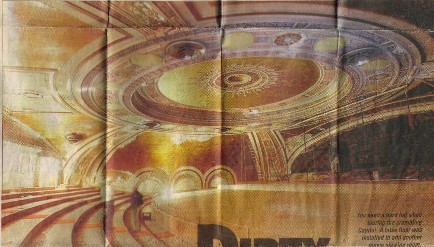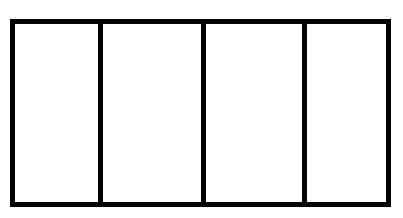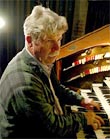|
|
 
|
|
Author
|
Topic: Picture size determined by old screen frames?
|
|
|
|
|
William Hooper
Phenomenal Film Handler
Posts: 1879
From: Mobile, AL USA
Registered: Jun 99
|
 posted 02-03-2005 01:49 AM
posted 02-03-2005 01:49 AM





That picture is giving me a headache!
It looks more like the back of the house at the top of the balcony than the front end, & the seats have been removed from the risers in the balocony. The bright white lighted areas could be hallways or vestibules brightly lighted by worklights or open windows, blowing out the exposure. They could even be just something as bright as fluorescents (although the wrong color), if there's little light in the auditorium. I'm baffled by what looks like a flat floor forward of the risers in the balcony that extends to the concave "sounding board" construction over the proscenium & orchestra pit. If it were scaffolding for ceiling restoration, it wouldn't be so closely matched & finished at the walls.
That flat floor-looking thing is more than 25' feet above the main floor: above the top of the proscenium!
The more I look at it, the rake of the balcony really doesn't match typical balcony rake for theaters of that age. I wonder if this is a restoration job where they've re-raked the balcony, screwing up the sightlines? Shoot, you can't even see the stage at that angle! Are they creating a new auditorium with stadium seating by chopping the top off of an existing older theater?
Somebody stole their chandelier!
quote:
Also, lets say the screen frame looks like this:
I'm with John, if you're referring to something that you see in the picture, you can't draw a conclusion from it.
If the screen frame is really the screen frame onstage (not pictured), then yes, allowing 6" or so for lacing around all edges, & without knowing whether there was moveable horizontal masking attached which even when pulled all the way out would have taken up a couple of feet at the ends of the screen frame, you can sort of estimate from that frame.
But if it's REALLY old, from when the theater was a silent movie theater, the screen only went in the center 20' or so, & the ends had attached decorative material to provide a "stage setting" for the screen. That's very unlikely, that the screen wasn't changed or removed from the silent days.
Does it really have a center vertical bracing member, right where the center speaker should go?
| IP: Logged
|
|
|
|
|
|
|
|
Andrew McCrea
Jedi Master Film Handler

Posts: 645
From: Winnipeg, Manitoba, Canada
Registered: Nov 2000
|
 posted 02-03-2005 04:06 PM
posted 02-03-2005 04:06 PM





That's the Capitol Theatre in Winnipeg. It opened February 14, 1921, in an attempt to put the Allen Chain under. it was built on one side of Portage Avenue, and the Allen was on the other. The Allen was renamed the Metropolitan, and its been kept standing. Unfortunately, the The Cap that you'll see in an upcoming picture gallery, was demolished in 2001 or 2002.
It showed movies up until it closed on September 3, 1990. It required steam heating, and Winnipeg shut its plant in the spring of 1990, so the theatre operated until it got too hold. Thus, it was completely stripped (The left the seats and speakers at the Met) and sat with no heat until the city acquired both properties from Famous Players in exchange for a $775,000.00 tax receipt (They were mad that the city wanted to designate both of them). When the city took them over, they put furnaces into the Capitol. Unfortunately, by 2001, most of the fake ceilings Famous Players put up had fallen to the floor, making the place look worse than it was. The Capitol was subsequently delisted as a heritage building (WHAT'S THE BLOODY POINT OF LISTING IF IT CAN BE TAKEN OFF WITH A SIMPLE VOTE) and torn down.
It was designed by Thomas W. Lamb and originally had a seperate building for its entrance with an enclosed bridge over the backlane to the theatre. In 1964, that entrance was closed and demolished for development. In 1979, the theatre was split horizontally at the balcony instead of vertically (there were protests).
Its unfortunate, but after the gallery goes up, I'll post some picture prior to the split from the Winnipeg archieves. As for the chancelier, it fell to the floor one night (while closed) and was never replaced.
| IP: Logged
|
|
Richard C. Wolfe
Master Film Handler

Posts: 250
From: Northampton, PA, USA
Registered: Apr 2000
|
 posted 02-04-2005 12:56 AM
posted 02-04-2005 12:56 AM





Quote: [It doesn't even look like a movie theatre. Looks more like a stage theater, given the size of that stage. Is it maybe a "legitimate" theater that showed movies once in a while? In that case, the screen could be just about any size depending on the height of the proscenium.]
No it wasn't a legitimate theatre, it was a movie palace. That's the way MOST movie theatres looked back in the 1920s. I grew up in a town of about 35,000 people. Back in the 50s, we still had 3 large ornate movie palaces downtown, and several other smaller less ornate ones as well.
Those theatres were usually always built with full stage facilities, so they could also run vaudeville acts or live prologues that were themed to the storyline of the feature film. They generally sat any where from 1000 to 3000 people, even more in larger cities. The New York Roxy had about 6,000 seats, the Atlanta Fox 5,000 and so on. One reason for adding live entertainment to movie shows was to legitimize the movies for all classes of people. During the early years from 1908 thru the teens, movies were considered entertainment only for the poor and generally for men. It was through the efforts of Marcus Lowe, William Fox, Sid Grauman, and particularly Samuel (Roxy) Rothafel that movie presentations were upgraded to where they were accepted by all people, and particularly by the church, and the schools. By adding the opulence usually found only in hotels, banks, and other large public buildings, and even out doing legitimate theatres, and with the addition of the live acts, movies became accepted as a form of the arts.
About a hundred of those movie palaces have been saved and restored as performing arts centers thoughtout America. It's a shame that most young people today when attending shows at those theatres don't even realize that they were just normal movie theatres back when they were new.
If you have one in your area, make a point to visit it and see what is missing in our theatres today. Movie theatres over the past decade have improved greatly, but still for the most part don't come near what us older folks experienced during our younger years at our local movie palace.
| IP: Logged
|
|
|
|
|
|
|
|
All times are Central (GMT -6:00)
|
|
Powered by Infopop Corporation
UBB.classicTM
6.3.1.2
The Film-Tech Forums are designed for various members related to the cinema industry to express their opinions, viewpoints and testimonials on various products, services and events based upon speculation, personal knowledge and factual information through use, therefore all views represented here allow no liability upon the publishers of this web site and the owners of said views assume no liability for any ill will resulting from these postings. The posts made here are for educational as well as entertainment purposes and as such anyone viewing this portion of the website must accept these views as statements of the author of that opinion
and agrees to release the authors from any and all liability.
|

 Home
Home
 Products
Products
 Store
Store
 Forum
Forum
 Warehouse
Warehouse
 Contact Us
Contact Us




 Printer-friendly view of this topic
Printer-friendly view of this topic










![[Frown]](frown.gif)







